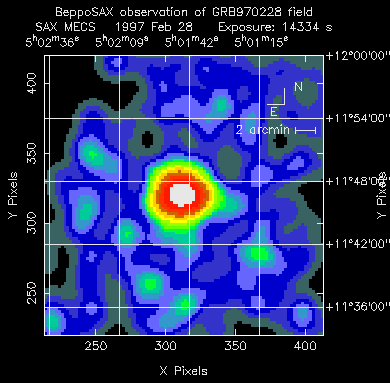Explanation: What and where are the Gamma-Ray Bursters? Since their discovery in the early 1970s, nobody has been able to explain the cause of mysterious flashes of gamma rays that come from seemingly random directions on the sky. Worse yet, it is even unclear whether these high energy explosions originate in our own Galaxy or in distant galaxies across the Universe. Until late last month, these bursters were known only by their gamma-ray flashes - no counterpart had been seen at any other wavelength. But on February 28, an Italian/Dutch satellite known as BeppoSAX detected what may well be X-rays from a burster, eight hours after the gamma-ray flash. The discovery image is shown above. Still hours later, using the position provided by this X-ray image, ground-based telescopes recovered an even better located variable optical source which also seems to be related to the burster. Dramatically, this optical transient has faded now. In its place lies a steady source that appears to be a dim, distant galaxy. Did this Gamma-Ray Burst originate in the distant galaxy? If so, it answers one facet of one of modern astronomy's greatest controversies. If not, this would not be the first fortuitous coincidence to mislead astronomers. Future satellite and ground-based observations will tell.
1999 2000 2001 2002 2003 2004 2005 2006 2007 2008 2009 2010 2011 2012 2013 2014 2015 2016 2017 2018 2019 2020 2021 2022 2023 2024 2025 |
Январь Февраль Март Апрель Май Июнь Июль Август Сентябрь Октябрь Ноябрь Декабрь |
NASA Web Site Statements, Warnings, and Disclaimers
NASA Official: Jay Norris. Specific rights apply.
A service of: LHEA at NASA / GSFC
& Michigan Tech. U.
|
Публикации с ключевыми словами:
гамма-всплески - рентгеновские лучи - далекие галактики
Публикации со словами: гамма-всплески - рентгеновские лучи - далекие галактики | |
См. также:
Все публикации на ту же тему >> | |
